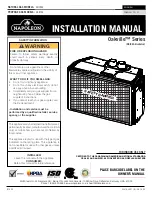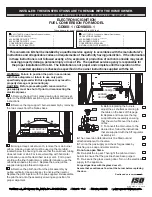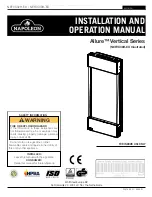
Magnafire Series Coal Stoves
7
3-90-70746R12_10/13
Venting
3. Venting & Chimneys:
3.1 TYPES OF CHIMNEYS
The chimney is one of the most important, yet the most
neglected and misunderstood portion of any solid fuel
burning appliance installation. Do not connect your stove to
a chimney flue that already serves another heating device.
The stove must be connected to its own flue. A minimum 8”
X 8” is necessary for proper operation.
Under no circumstances should a manual flue damper
be installed in the smoke pipe between the stove and the
chimney.
CAUTION! THE CHIMNEY MUST bE A “CLASS A”
CHIMNEY IN GOOD WORKING CONDITION. THE USE
OF ALUMINUM “TYPE b” GAS VENT FOR SOLID FUELS
IS NOT ONLY UN-SAFE bUT IT IS PROHIbITED bY THE
NATIONAL FIRE PROTECTION AGENCY (NFPA) CODE.
There are three types of “Class A” chimneys;
1. Masonry with a tile liner, including brick, block, stone,
etc. It must be supported by a ground-level foundation.
2. Insulated “Class A” manufactured chimney, listed and
certified by a national test agency.
3. Triple-walled metal “Class A” chimney, listed and certified
by a national test agency.
If your masonry chimney has not been used for some time,
have it inspected by a qualified person (building inspector,
fire department personnel, etc.). If a listed and certified
manufactured chimney is to be used, make certain it is
installed in accordance with the manufacturers instructions
and all local codes.
A coal stove can perform only as well as its venting system
will allow it to.
3.2 COMMON CHIMNEY PROBLEMS
In order to have a properly operating heating system, the
chimney needs to be capable of providing sufficient draft.
The minimum required draft is .06 inches of water column
(WC). To measure the draft, drill a hole in the connector
pipe and attach a draft meter. First, check the draft above
the barometric damper (if installed). Then check it below
the barometric damper and make your damper adjustment
to where it opens to prevent the draft from going higher
than the .06 in WC. If the chimney is incapable of supplying
the necessary draft, it will need to be improved. Whether it
needs to be raised to a taller height, a flue liner installed, or
a different style of cap placed on the top, the improvement
method will need to be determined.
Reasons for insufficient draft;
A. Leaking chimney- Air leaking in around a loose fitting
cleanout door, joints or seams in connector pipe are not
secured properly, cracks or other defects in masonry.
b. Improper chimney height - Chimney does not extend to
a sufficient height above the roof line. (Remember the 3
ft.-2 ft.-10 ft. rule)
C. Obstructions in the chimney - Make sure the chimney
has been cleaned. Different animals have been known
to build nests in chimneys.
D. Trees or other topographical barriers - Trees that are
taller than the house can cause the air currents to flow
downward over the peak of the roof. This would lead
to a down draft effect on the chimney. This can also be
caused by adjacent buildings or fixtures. It could even be
from a different peak on the same structure.
Where an existing chimney is used, it must be large enough
to provide a draft adequate for removing the gaseous
products of combustion. The cross-sectional area of the
chimney must be at least 25 percent greater than that
of the connector. As a general rule, common 8” X 8” flue
liner has an actual interior cross-sectional area of 42 to 49
inches. This is adequate for a 6 inch stove connector, which
matches the appliance flue collar.
IMPORTANT!
The connector pipe must be constructed of
24 gauge material or thicker.
Wind direction
Содержание Magnafire Series Coal Stove Mark I
Страница 2: ...3 90 70746R12_10 13...
Страница 21: ...3 90 70746R12_10 13...








































